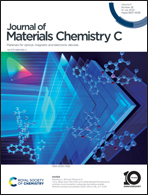Ultrahigh sensitivity upconversion low temperature sensors via manipulating the non-thermally coupled levels of Er3+ ions†
Abstract
Realizing high-sensitivity, accurate non-contact cryogenic optical thermometry based on upconversion (UC) luminescence holds significant application value in numerous advanced technology fields. Here, we report a novel temperature sensing strategy using the non-thermally coupled levels (NTCLs) formed by the blue emission level (2H9/2) based on Er3+ ions, which exhibit ultrahigh sensitivity under the excitation of two lasers (980 or 1550 nm). The prepared glass-ceramic (GC) containing Er,Yb:NaYF4 possesses excellent UC luminescence performance, and could respond to 980 and 1550 nm wavelength excitation and produce apparent blue emission. The fluorescence intensity ratio (FIR) optical thermometry of NTCLs containing blue emission levels (2H11/2–2H9/2, 4F9/2–2H9/2) has higher absolute and relative sensitivity, thanks to the more pronounced difference in response to temperature of NTCLs that absorb different numbers of photons. Based on the 2H11/2–2H9/2 NTCL, the maximal value of SR is 5.608% K−1 (5.339% K−1) under 980 (1550 nm) excitation, which is greater than that of the TCL and traditional 4F9/2–4S3/2 NTCL. The results indicate that the prepared GC material has a great improvement in the sensitivity of temperature sensing, while providing a novel strategy for realizing ultrahigh sensitivity dual-mode optical thermometry.



 Please wait while we load your content...
Please wait while we load your content...